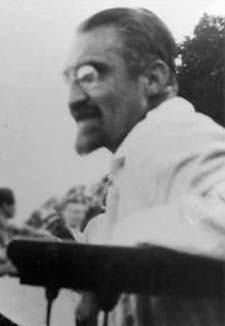


 تاريخ الرياضيات
تاريخ الرياضيات
 الرياضيات في الحضارات المختلفة
الرياضيات في الحضارات المختلفة 
 الرياضيات المتقطعة
الرياضيات المتقطعة
 الجبر
الجبر
 الهندسة
الهندسة 
 المعادلات التفاضلية و التكاملية
المعادلات التفاضلية و التكاملية 
 التحليل
التحليل
 علماء الرياضيات
علماء الرياضيات |
Read More
Date: 22-5-2017
Date: 22-5-2017
Date: 24-5-2017
|
Died: 17 February 1964 in Munich, Germany

Heinrich Tietze's father was Emil Tietze, the Director of the Geological Institute at the University of Vienna, and his mother was Rosa von Hauer, who was the daughter of the geologist Franz Ritter von Hauer. Tietze was a student at the Technische Hochschule in Vienna, starting his studies there in 1898. At Vienna he formed a close friendship with three other students of mathematics, Paul Ehrenfest, Hans Hahn and Gustav Herglotz. They were known as the 'inseparable four'.
It was his friend Herglotz who suggested that Tietze spend a year in Munich, and indeed he went there in 1902 to continue his studies. Returning to Vienna, Tietze was supervised during his doctoral studies by Gustav von Escherich and he was awarded his doctorate in 1904. Wirtinger, who had himself studied at Vienna, spent ten years at the University of Innsbruck before returning to a chair at the University of Vienna in 1905. He lectured on algebraic functions and their integrals in his first year back in Vienna, and Tietze attended these lectures and because of them formed an instant liking for topological notions which would from that time on be his main research topic.
Tietze submitted his habilitation thesis to Vienna in 1908 and this was on a topological topic considering topological invariants. From 1910 he was an extraordinary professor of mathematics at Brünn (today called Brno), and in 1913 he was promoted to ordinary professor. His career was interrupted, however, in 1914 by the outbreak of World War I.
At the start of the war Tietze was called up to serve in the Austrian army. He served for the duration of the war, returning to Brünn when hostilities had ended. The following year, in 1919, he accepted the chair of mathematics at the University of Erlangen. After six years in Erlangen, Tietze accepted a chair at the University of Munich. He remained in Munich for the rest of his life, retiring from his chair in 1950 but continuing his mathematical research almost up to the time of his death at age 83. Of course this means that Tietze spent the difficult years of Nazi control of Germany at Munich and this had many unfortunate consequences.
Litten, in [3], gives details of one such difficulty. Caratheodory was a colleague of Tietze's at Munich until he retired in 1938. The quest for a successor took from 1938 until 1944 and resulted in unbelievably complex political considerations. Tietze and his colleagues drew up a short list of three candidates to replace Caratheodory. These were Herglotz, van der Waerden and Siegel. However, all three were opposed by the Nazi professors at Munich for political reasons. Litten describes the arguments which involved considering the political reliability and the number of Jewish friends of the candidates.
Tietze contributed to the foundations of general topology and developed important work on subdivisions of cell complexes. The paper [5] lists six books and 104 papers written by Tietze. The bulk of this work was carried out after he took up the chair at Munich in 1925.
Fundamental groups were introduced by Poincaré in 1895 and, in 1908, Tietze recognised that from the abelianised fundamental group of a space all the earlier invariants could be calculated. In that 1908 paper, Tietze produced a finite presentation for the fundamental group and invented the now well-known Tietze transformations to show that fundamental groups are topological invariants. The now famous Tietze transformations change one presentation of a finitely presented group to another presentation without changing the group which is defined by the presentation. It is possible to go from any given finite presentation of a group to any other using Tietze transformations.
In the same 1908 paper Tietze gives the first reference to the isomorphism problem for groups, namely: if two groups are defined by finite presentations, is there an algorithm to decide whether they are isomorphic or not? Of course Tietze gives the problem in the context of fundamental groups of topological spaces.
It is probably fair to say that von Dyck initiated the study of combinatorial group theory but then Tietze made the first major step forward. Among the topics in topology which Tietze worked on were knot theory, Jordan curves and continuous mappings of areas. Tietze also wrote on map colouring and wrote a well known book Famous Problems of Mathematics. Seebach writes [1]:-
It shows his gift for representing even difficult mathematical questions in a very clear and impressive manner for interested people.
Topics outside topology which Tietze worked on included ruler and compass constructions, continued fractions, partitions, the distribution of prime numbers, and differential geometry.
Tietze received many honours for his contributions. In particular he was elected a member of the Bavarian Academy of Sciences and served two terms (1934-42 and 1946-51) as Secretary to the Mathematics and Natural Sciences Division. He was also elected a Fellow of the Austrian Academy of Sciences in 1959.
Books:
Articles:



|
|
|
|
مخاطر عدم علاج ارتفاع ضغط الدم
|
|
|
|
|
|
|
اختراق جديد في علاج سرطان البروستات العدواني
|
|
|
|
|
|
|
مدرسة دار العلم.. صرح علميّ متميز في كربلاء لنشر علوم أهل البيت (عليهم السلام)
|
|
|